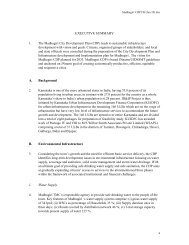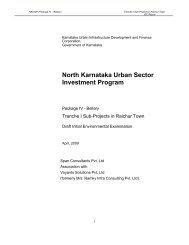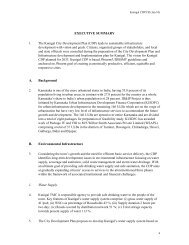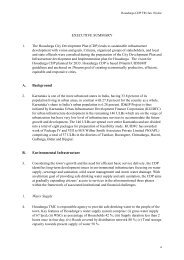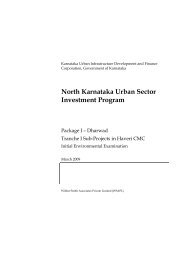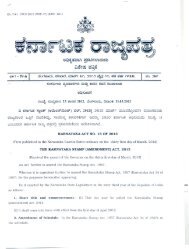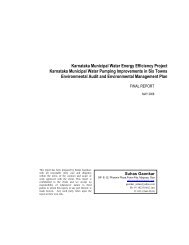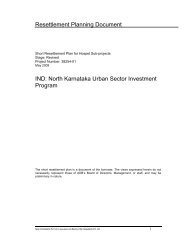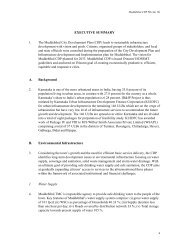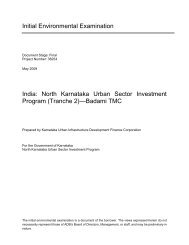Davangere 38254-053-ind-iee-02.pdf - kuidfc
Davangere 38254-053-ind-iee-02.pdf - kuidfc
Davangere 38254-053-ind-iee-02.pdf - kuidfc
You also want an ePaper? Increase the reach of your titles
YUMPU automatically turns print PDFs into web optimized ePapers that Google loves.
1663. Air Quality. Emissions from construction vehicles, equipment, and machinery used forexcavation and construction will <strong>ind</strong>uce impacts on the air quality in the construction sites.Anticipated impacts include dusts and increase in concentration of vehicle-related pollutantssuch as carbon monoxide, sulfur oxides, particulate matter, nitrous oxides, and hydrocarbons)but temporary and during construction activities only. To mitigate the impacts, constructioncontractors will be required to:(i)(ii)(iii)(iv)Consult with PMU/CSS on the designated areas for stockpiling of, soils, gravel,and other construction materials;Damp down exposed soil and any stockpiled on site by spraying with water whennecessary during dry weather;Use tarpaulins to cover sand and other loose material when transported bytrucks; andFit all heavy equipment and machinery with air pollution control devices whichare operating correctly.64. Surface Water Quality. Mobilization of settled silt materials/dredged slurry, run-off fromstockpiled materials, and chemical contamination from fuels and lubricants during constructionworks can contaminate the water. These potential impacts are temporary and short-termduration only and to ensure these are mitigated, construction contractor will be required to:(i)(ii)(iii)(iv)(v)(vi)(vii)Avoid stockpiling of earth fill especially during the monsoon season unlesscovered by tarpaulins or plastic sheets;Prioritize re-use of excess spoils and materials in the construction works. If spoilswill be disposed, consult with PMU/CSS on designated disposal areas;Install temporary silt traps or sedimentation basins along the drainage leading tothe water bodies;Place storage areas for fuels and lubricants away from any drainage leading towater bodies;Dispose any wastes generated by construction activities in designated sites; andConduct surface quality inspection according to the Environmental ManagementPlan (EMP).The construction contractor will be required to conduct excavation, dredging anddesiltation works on non-monsoon season. No waste water from the site shouldbe diverted to the lake.65. Noise Levels. Increase in noise level may be caused by excavation equipment, and thetransportation of equipment, materials, and people. Impact is negative, short-term, andreversible by mitigation measures. The construction contractor will be required to:(i)(ii)(iii)(iv)Plan activities in consultation with PMU/CSS so that activities with the greatestpotential to generate noise are conducted during periods of the day which willresult in least disturbance;Horns should not be used unless it is necessary to warn other road users oranimals of the vehicle’s approach;Minimize noise from construction equipment by using vehicle silencers, fittingjackhammers with noise-reducing mufflers, and portable street barriers the soundimpact to surrounding sensitive receptor; andMaintain maximum sound levels not exceeding 80 decibels (dbA) whenmeasured at a distance of 10 m or more from the vehicle/s.



